The concretization of the term sustainable spatial development for the assessment of child and juvenile awareness
The concretization of the term sustainable spatial development for the assessment of child and juvenile awareness
Author(s): Andreja Istenič Starčič, Maruška Šubic Kovač, Špela Verovšek, Matija Svetina, Tomaž Novljan, Matevž Juvančič, Tadeja ZupančičSubject(s): Social Sciences
Published by: Urbanistični inštitut Republike Slovenije
Keywords: cultural dimensions of spatial sustainability; architecture; built environment; lifelong learning; children and juveniles
Summary/Abstract: The following article is targeted at the comprehensive co-shaping of the conditions required for the active education on the effective and concrete contributions to sustainable development, with the emphasis based on the built environment or architecture. It defines the role of education on the built environment or architecture within the concept of sustainable development, determines the grounds for adjusting the methods of delivering architectural contents and defines the educational contents along with their presentations with regards to the developmental abilities of the public, which is targeted. It presents the deliberation on objectifying the term sustainable spatial development, for the assessment of child and juvenile awareness of “sustainable architecture” topics as well as determining childcare workers and teachers adequate qualifications to provide the knowledge in the field of the built environment, in relation to sustainable environment. Concretisation signifies the selection and visualisation of actual topical occurrences in physical space for a specific targeted public (the article provides representative models). It also contributes to the development of “cultural” dimension of spatial development sustainability. The efforts made to strive towards the lifelong learning of architecture and its influence on our everyday lives and our future.
Journal: Urbani izziv
- Issue Year: 20/2009
- Issue No: 1
- Page Range: 153-163
- Page Count: 11
- Language: English

